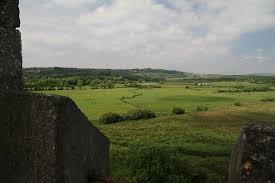10 May 1318: The Battle of Dysert O'Dea was fought on this
day. It took place near near Corofin, Co Clare. The battle occurred during the
Bruce Invasion of Ireland.
The Anglo Norman Lord Richard De Clare ( a descendant of
Strongbow) attacked the Irish chieftain Conor O’Dea, chief of the Cineal
Fearmaic and the ally of King
Muirchertach O’Brien of Thomond.
De Clare made the mistake of dividing his army in three in the
face of the enemy and he led the van towards Castle Dysert O’Dea – the home of
the Irish Chieftain. O’Dea held them at the ford of Fergus and sent messengers
out to bring up reinforcements as De Clare charged at his opponents only to be
surrounded and cut down by the axe of Conor O’Dea himself.
As the rest of the Anglo Norman force came up they waded
into the Irish and were on the point of extracting a bloody revenge when Felim
O'Connor's troops charged down the hill of Scamhall (Scool) and cut a path
through the English to join the battle. De Clare's son then arrived on the
scene and was cut down and killed by Felim O'Connor
As the two forces were locked in this deadly struggle both
expected reinforcements to arrive and as King Muirchertach O'Brien’s men
galloped onto the scene Conor O’Dea almost lost heart until he heard the Irish
war cries and knew the victory was won. Soon
Lochlann O'Hehir and the MacNamaras joined the fight and it was all over for
the Anglo Normans who went down fighting.
‘so dour the hand to hand work was , that neither noble or
commander of them left the ground but the far greater part fell where they
stood.’
Irish Battles, G.A. Hayes McCoy
The power of one of the great Anglo Norman families was
shattered forever. In the wake of this victory King Muirchertach O'Brien
advanced upon the environs of Bunratty
Castle, home of the De Clare’s to find much of it burnt by De Clare’s widow who
promptly fled to England. The Castle though held out for a couple of weeks and
the Irish completely destroyed it in 1322. The De Clare’s never returned and
Thomond west of the Shannon remained under Irish rule until the early 17th
Century. It was the greatest Gaelic victory of the Bruce War.


No comments:
Post a Comment